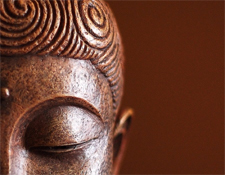

Let’s get one thing straight: I’m a bit high-strung. And by “bit” I mean a tighter than an 18th Century corset clamped down on an anorexic. So when I discovered a ten-day meditation course in northern India, I leapt at the chance.
Let’s back up for a second. You need to understand how this all happened. It all began when my dear friend Joshie-Boy began practicing meditation in his mid-twenties. Now mind you, Joshie-Boy and I have known each other since high school; we partied together, traveled together and – like Bill Murray says in Caddyshack – “someone to, you know, just get weird with”. In other words: good friends.
Now ole’ Joshie-Boy always had a mind. While most people’s brains swing one way (artistic or mechanical, analytic or creative) Joshie-Boy’s swung back and forth like a pendulum. A talented writer, he also built his own car, took up cooking and took up French for fun.
But brains can swing out of control, and the stronger the pendulum, the stronger the whiplash. I guess I don’t need to tell you Josh could get a little… eccentric.
Then – almost overnight – Josh found inner peace. (And you can find inner peace at work!)
The change was profound. The man hopscotched from Van Gogh to Yoda in a series of days.
Intrigued, I picked his newly reconstructed brain. As it turned out, he began a form of meditation called Vipassana. He enjoyed the results so much he flew to India (and later Burma) to refine the technique.
Now you might react like I did: meditation in India? Sounds a little new-age, doesn’t it? I envisioned sickly looking Vegans sitting lotus-style in three year-old Sarongs…
… but the change is Joshie-Boy was 100% positive.
So – as travelers are apt to – I leapt without looking. Without knowing a thing about Vipassanna, my wife Darcie and I enrolled in the same mediation course in India.
I’ll tell you about the technique in a second. But first, a little history. Vipassana wasn’t developed by some New Age guru who accepts credit cards like karma…
No, the method was developed by none other than Siddartha Gautama, known affectionately by BILLIONS of people as Buddha, or “enlightened one”.
Siddartha was born a prince, but after seeing the suffering in the world decided to do something about it. He practiced various forms of meditation, yet none seemed to alleviate that suffering at its root.
It was then Siddartha devised a method so powerful, so effective and so simple anyone could do it and almost immediately reap the benefits.
According to Siddartha, human suffering results from two conditions: craving and aversion. In other words: we spend life either running towards what we want, or away from what we don’t. Our minds are constant pulled this way and that, which results in a perpetual state of distress.
The solution to this is quite simple. The Buddha realized that – in order to end suffering – people must train themselves not to react.
Sounds simple… and it is. But it sure ain’t easy.
You see, our body reacts with our emotions. When angry, you feel hot; when nervous, your stomach turns, etc. The key is training your mind to observe – not react – to these stimulations.
In other words, you must train your mind to acknowledge what is happening without committing to it.
For example, you become enraged when the Internet connection goes down. Instead of reacting (throwing things, complaining, or going Office Space on your computer), Vipassana teaches your mind to observe the sensations of your body.
The Buddha lived and breathed one simple tenet: we cannot control what happens in life; but we can control how we react to them.
So this all sounds well and good, but the question remains: just how can you train yourself not to react to positive or negative stimulations in the world?
Buddha’s answer is as applicable now as it was twenty-five hundred years ago: sit quietly and focus intently on a specific part of your body. Observe all sensations – tingling, burning, pain, pleasure – without reacting (almost as if your mind is a third-party).
Just observe.
During my ten-day Vipassana course in McLeod Ganj (a small town in northern India), we would sit and concentrate for a total of ten and half hours a day…
… slowly working our attention from the crown of our head down to our toes. Then back up, and down again.
And so on.
During this course, it quickly became apparent how distracting life really is. Even while meditating, I found myself working through business plans, worrying about bills and dreaming of becoming wealthy…
But after a few days, all that faded to the background. I became increasingly aware of my body, and its different sensations.
Perhaps most importantly, as my body began to feel the pain of sitting cross-legged for over tens hours a day… my mind became adept at merely observing the discomfort (instead of reacting ).
And this – for me, anyways – was the main benefit of Vipassana. Once my mind stopped reacting, I achieved a level of clarity I never had before.
For weeks afterward, I could relax at will (doubly amazing considering we were traveling through India at the time).
And inner peace? Yep – I got me some of that, too.
Leave a Reply